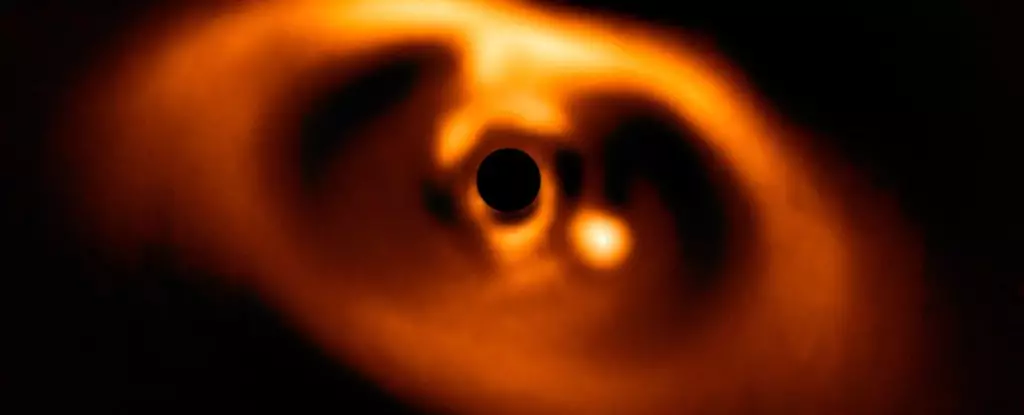The field of astronomy has entered what can be described as a revolutionary chapter, characterized by transformative insights and cutting-edge technology. This period, often referred to as “the age of shifting paradigms,” marks a departure from established theories, particularly regarding the formation of planetary systems. Traditional models, such as the Nebular Hypothesis, long held sway—positing that star systems originate from vast clouds of gas and dust (nebulae) subjected to gravitational collapse. However, recent discoveries have calls into question the simplistic notions that have dominated for centuries, pushing scientists to rethink how planets and their atmospheres are formed.
In an era where advanced telescopes and machine learning algorithms facilitate unprecedented observations, researchers are now uncovering complex relationships within the cosmos. Notably, recent investigations of the exoplanet PDS 70b demonstrate how the gases in its atmosphere diverge from those found in the surrounding protoplanetary disk. Such findings challenge the established correlation between a planet’s composition and that of its formative materials, suggesting a much more intricate evolutionary process.
A pivotal study led by Postdoctoral Associate Chih-Chun “Dino” Hsu from Northwestern University’s Center for Interdisciplinary Exploration and Research in Astrophysics (CIERA) illuminates the nuances of exoplanet development. Along with collaborators from reputable institutions such as the California Institute of Technology (Caltech) and the University of California campuses, the team closely examined PDS 70b while it orbits a young, variable star located 366 light-years away. This exoplanet stands out as one of the few actively forming planets observed within its nascent disk environment.
Utilizing the Keck Planet Imager and Characterizer (KPIC)—a revolutionary instrument at the W.M. Keck Observatory—the researchers were able to glean invaluable data from the faint light emitted by the still-evolving exoplanet. Their findings indicate that understanding planet formation necessitates a detailed analysis of both the planets and the various materials in their natal environments. Hsu’s commitment to merging observational data with theoretical predictions ultimately unveils inconsistencies that may reshape our view of cosmic evolution.
The research team’s ability to isolate and analyze the faint atmosphere of PDS 70b, particularly in the face of a dominant host star’s brightness, marks a significant leap in observational astrophysics. The spectra they obtained revealed vital components, particularly carbon monoxide and water vapor, which allowed for the calculation of the exoplanet’s carbon-to-oxygen ratio. The unexpected finding—a lower carbon-to-oxygen ratio in PDS 70b’s atmosphere compared to the surrounding disk—stirs fundamental questions about the mechanisms of planet formation.
According to Hsu, initial hypotheses predicted that the atmosphere of the forming planet would closely mirror the composition of the protoplanetary disk. This assumption now appears oversimplified, as emerging data suggest that the process of accreting materials—both gaseous and solid—could play a more substantial role than previously considered. The implications of this research ripple across the celestial arena, urging a reevaluation of the paradigms which govern our understanding of planetary birth.
To account for the mismatched carbon-to-oxygen ratios, the researchers propose two primary explanations: either the planet formed at a time when the disk was not yet enriched with carbon, or it primarily accumulated solids—possibly icy and dust-based materials—rather than relying on gas accretion alone. This complexity introduces variables that significantly alter prevailing theories on planet formation, suggesting that solid components might substantially influence atmospheric composition. The results derived from Hsu’s study hint at an ever-evolving understanding that highlights the interplay of both gaseous and solid accretion mechanisms.
As the team turns its attention to additional observations—particularly regarding the other fledgling exoplanet in the system, PDS 70c—future studies promise to deepen our comprehension of planetary formation dynamics. The exploration of both exoplanets will offer further insights into the broader context of this unique star system, laying the groundwork for revising the simplified models which have shaped our understanding thus far.
Ultimately, the burgeoning field of exoplanet research, bolstered by cutting-edge technologies and collaborative endeavors, is redefining our cosmic narrative. Each new observation not only adds depth to our knowledge but also invites further inquiry into the nature of our universe—reminding us that we are just beginning to scratch the surface in our quest to understand the cosmos. The ongoing exploration of systems like PDS 70b will undoubtedly challenge our preconceived notions and inspire a new generation of astronomical discoveries.


Leave a Reply